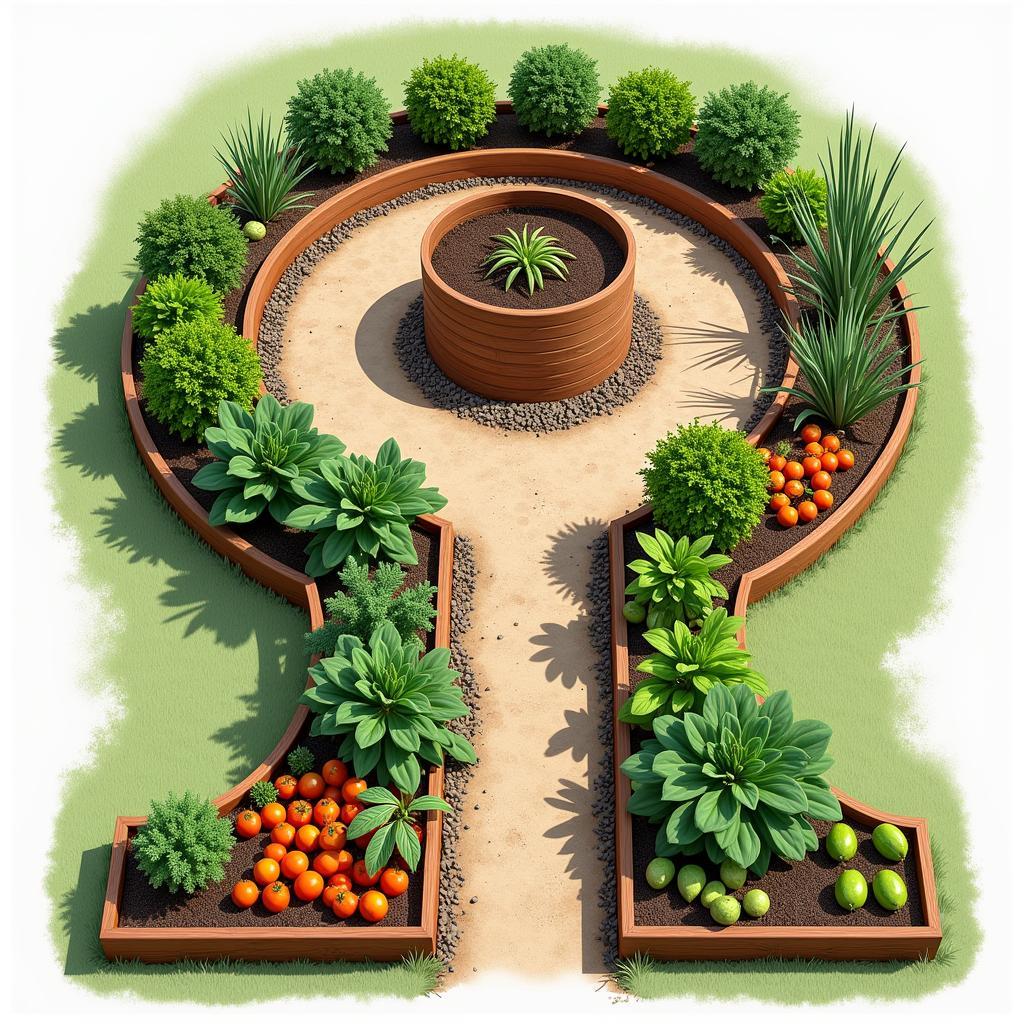Unlock Food Security with the African Keyhole Garden
An African Keyhole Garden is a raised, circular garden bed with a composting basket in the center, providing a sustainable and efficient way to grow food, even in challenging conditions. It’s a simple yet ingenious design that offers numerous benefits, from water conservation and improved soil fertility to reduced pest and disease problems. This article explores the principles, construction, and advantages of this innovative gardening technique, offering a practical guide for anyone interested in establishing their own keyhole garden.
The Genius of the African Keyhole Garden Design
The keyhole garden, so named for its keyhole-shaped entrance, originated in Lesotho, Southern Africa, as a response to drought and poor soil conditions. It’s essentially a raised bed, typically circular, with a central composting basket. This basket acts as the “stomach” of the garden, continuously feeding the surrounding soil with nutrients as kitchen scraps and other organic matter decompose. The raised design promotes drainage, while the composting system improves soil fertility and reduces the need for external fertilizers. This unique combination makes the African keyhole garden an excellent choice for arid climates and areas with limited access to resources.
 African Keyhole Garden Design: A Raised Bed with a Central Composting Basket
African Keyhole Garden Design: A Raised Bed with a Central Composting Basket
Building Your Own African Keyhole Garden: A Step-by-Step Guide
Creating an African keyhole garden is a relatively straightforward process. First, mark out a circular area about six feet in diameter. Then, build a retaining wall using readily available materials like stones, bricks, or recycled containers. Leave a small opening to create the “keyhole” entrance. Next, place a composting basket made of wire mesh or a perforated container in the center. Fill the outer ring with a mixture of soil, compost, and other organic matter. Finally, you can start planting your favorite vegetables, herbs, or flowers.
- Mark the area: Use string and stakes to define a circle approximately six feet in diameter.
- Build the retaining wall: Construct the wall about knee-high, leaving a keyhole-shaped opening for access.
- Place the composting basket: Position the basket in the center, ensuring it reaches the top of the wall.
- Fill the garden bed: Use a mixture of soil, compost, and organic matter like dried leaves or straw.
- Start planting: Choose plants suited to your climate and the garden’s location.
Benefits of the African Keyhole Garden
The keyhole garden offers numerous benefits, making it a sustainable and practical gardening solution:
- Water conservation: The raised bed and composting system retain moisture, reducing watering needs.
- Improved soil fertility: The composting basket continuously enriches the soil with nutrients.
- Reduced pest and disease problems: The healthy soil ecosystem helps prevent pests and diseases.
- Easy access: The keyhole pathway allows easy access to the center for composting and tending plants.
- Food security: Provides a reliable source of fresh produce, even in challenging environments.
“The keyhole garden is a testament to African ingenuity,” says Dr. Amani Jabari, an agricultural specialist based in Nairobi. “It’s a simple yet powerful tool for empowering communities and ensuring food security.”
Why Choose an African Keyhole Garden?
What makes the African keyhole garden so unique? It’s the combination of simplicity, efficiency, and sustainability. It’s an ideal solution for urban gardens, schools, and communities looking to enhance their food security. Its compact size and low maintenance make it perfect for beginners and experienced gardeners alike.
Conclusion: Cultivating a Sustainable Future with the African Keyhole Garden
The African keyhole garden is more than just a gardening technique; it’s a symbol of resilience and innovation. By adopting this simple yet effective method, individuals and communities can create sustainable food systems and contribute to a more secure future. Start your own keyhole garden today and experience the rewards of this ingenious African gardening solution.
FAQ
- What is the ideal size for a keyhole garden? A standard size is about six feet in diameter, but you can adjust it based on your available space.
- What materials can I use for the retaining wall? Stones, bricks, recycled containers, or even wood can be used.
- What can I compost in the central basket? Kitchen scraps, yard waste, and other organic matter are ideal.
- How often should I water my keyhole garden? Less frequently than traditional gardens, as the design retains moisture.
- What types of plants thrive in a keyhole garden? A wide variety, including vegetables, herbs, and flowers.
- How do I maintain my keyhole garden? Regular composting and occasional weeding are the main tasks.
- Where can I find more information on keyhole gardens? Online resources and community gardening groups offer valuable information.
Common Scenarios and Questions
- Dealing with pests in your keyhole garden: Companion planting and natural pest control methods are effective.
- Choosing the right plants for your climate: Research local climate conditions and select appropriate varieties.
- Maintaining the composting system: Ensure proper aeration and moisture levels in the compost basket.
Further Exploration
Explore other articles on our website related to sustainable gardening practices, composting techniques, and growing your own food.
Call to Action
For any assistance, please contact us at Phone: +255768904061, Email: kaka.mag@gmail.com Or visit us at: Mbarali DC Mawindi, Kangaga, Tanzania. We have a 24/7 customer support team.

